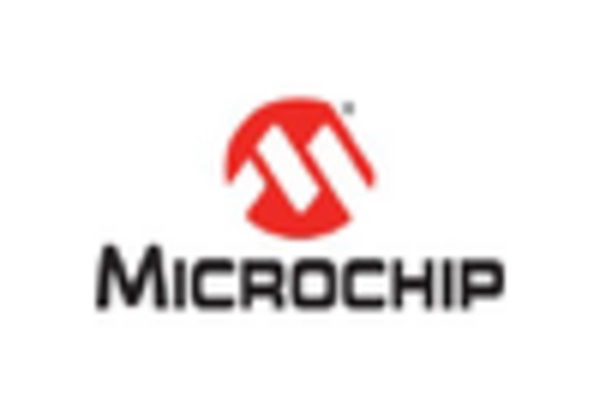Growing Adoption of IoT Devices
The increasing proliferation of Internet of Things (IoT) devices in the GCC region is a primary driver for the ultra low-power-microcontroller market. As industries and consumers alike embrace smart technologies, the demand for energy-efficient microcontrollers rises. In 2025, it is estimated that the number of connected IoT devices in the GCC will surpass 1 billion, necessitating the use of ultra low-power microcontrollers to ensure prolonged battery life and reduced energy consumption. This trend is particularly evident in sectors such as smart home automation, healthcare, and industrial applications, where low power consumption is critical. The ultra low-power-microcontroller market is thus positioned to benefit significantly from this growing adoption, as manufacturers seek to develop solutions that meet the energy efficiency requirements of these devices.
Expansion of Wearable Technology
The wearable technology sector is experiencing rapid growth in the GCC, which is a significant driver for the ultra low-power-microcontroller market. Devices such as fitness trackers, smartwatches, and health monitoring systems require microcontrollers that can operate efficiently on limited power. The market for wearables in the GCC is projected to reach $5 billion by 2025, highlighting the increasing consumer interest in health and fitness. As manufacturers strive to create more advanced and feature-rich wearable devices, the demand for ultra low-power microcontrollers will likely increase. This trend indicates a shift towards more sophisticated health monitoring solutions that prioritize energy efficiency, thereby enhancing the overall user experience.
Government Initiatives for Smart Cities
Governments in the GCC are increasingly investing in smart city initiatives, which is likely to bolster the ultra low-power-microcontroller market. These initiatives aim to enhance urban living through the integration of technology in infrastructure, transportation, and public services. For instance, the UAE's Vision 2021 emphasizes the development of smart cities, which will require a vast array of sensors and devices powered by ultra low-power microcontrollers. The market is projected to grow as municipalities implement smart lighting, waste management, and traffic monitoring systems, all of which rely on energy-efficient microcontrollers. By 2025, the investment in smart city projects in the GCC is expected to reach $100 billion, creating substantial opportunities for the ultra low-power-microcontroller market.
Rising Focus on Renewable Energy Solutions
The GCC region's commitment to diversifying its energy sources and increasing the share of renewables is influencing the ultra low-power-microcontroller market. As solar and wind energy projects expand, there is a growing need for efficient energy management systems that utilize ultra low-power microcontrollers. These microcontrollers play a crucial role in monitoring and controlling energy consumption in renewable energy applications. The market is likely to see a surge in demand as the GCC aims to generate 50% of its energy from renewable sources by 2030. This shift not only supports sustainability goals but also drives innovation in the ultra low-power-microcontroller market, as manufacturers develop specialized solutions for energy management.
Technological Advancements in Wireless Communication
Advancements in wireless communication technologies, such as 5G, are poised to impact the ultra low-power-microcontroller market positively. The GCC is at the forefront of adopting 5G technology, which enables faster data transmission and improved connectivity for various applications. This evolution necessitates the use of ultra low-power microcontrollers that can efficiently manage communication tasks while conserving energy. As industries leverage 5G for applications like smart manufacturing and autonomous vehicles, the demand for ultra low-power microcontrollers is expected to rise. By 2025, the number of 5G connections in the GCC is projected to reach 50 million, creating a substantial market opportunity for ultra low-power microcontroller manufacturers.
















Leave a Comment